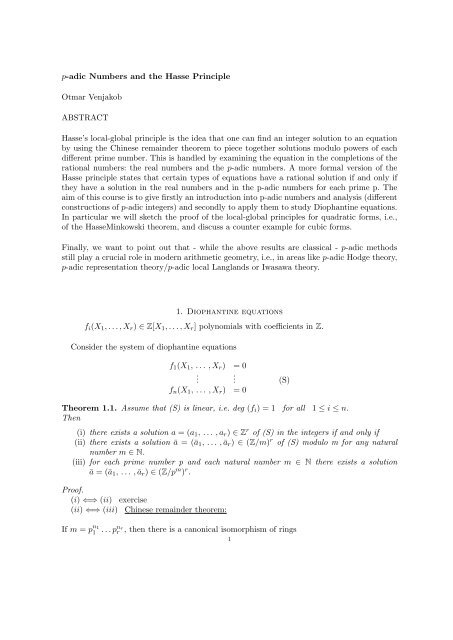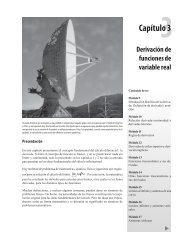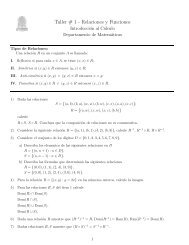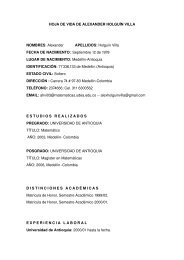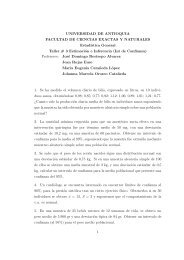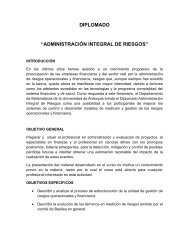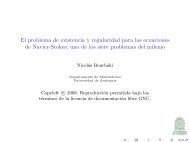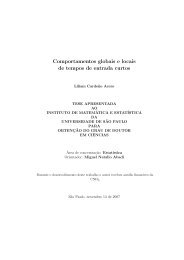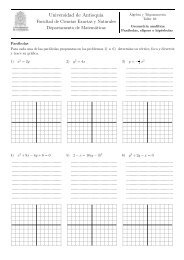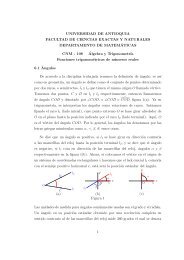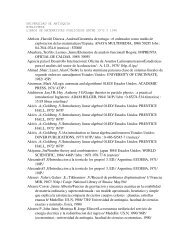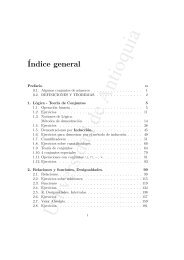p-adic Numbers and the Hasse Principle Otmar Venjakob ...
p-adic Numbers and the Hasse Principle Otmar Venjakob ...
p-adic Numbers and the Hasse Principle Otmar Venjakob ...
You also want an ePaper? Increase the reach of your titles
YUMPU automatically turns print PDFs into web optimized ePapers that Google loves.
p-<strong>adic</strong> <strong>Numbers</strong> <strong>and</strong> <strong>the</strong> <strong>Hasse</strong> <strong>Principle</strong><br />
<strong>Otmar</strong> <strong>Venjakob</strong><br />
ABSTRACT<br />
<strong>Hasse</strong>’s local-global principle is <strong>the</strong> idea that one can find an integer solution to an equation<br />
by using <strong>the</strong> Chinese remainder <strong>the</strong>orem to piece toge<strong>the</strong>r solutions modulo powers of each<br />
different prime number. This is h<strong>and</strong>led by examining <strong>the</strong> equation in <strong>the</strong> completions of <strong>the</strong><br />
rational numbers: <strong>the</strong> real numbers <strong>and</strong> <strong>the</strong> p-<strong>adic</strong> numbers. A more formal version of <strong>the</strong><br />
<strong>Hasse</strong> principle states that certain types of equations have a rational solution if <strong>and</strong> only if<br />
<strong>the</strong>y have a solution in <strong>the</strong> real numbers <strong>and</strong> in <strong>the</strong> p-<strong>adic</strong> numbers for each prime p. The<br />
aim of this course is to give firstly an introduction into p-<strong>adic</strong> numbers <strong>and</strong> analysis (different<br />
constructions of p-<strong>adic</strong> integers) <strong>and</strong> secondly to apply <strong>the</strong>m to study Diophantine equations.<br />
In particular we will sketch <strong>the</strong> proof of <strong>the</strong> local-global principles for quadratic forms, i.e.,<br />
of <strong>the</strong> <strong>Hasse</strong>Minkowski <strong>the</strong>orem, <strong>and</strong> discuss a counter example for cubic forms.<br />
Finally, we want to point out that - while <strong>the</strong> above results are classical - p-<strong>adic</strong> methods<br />
still play a crucial role in modern arithmetic geometry, i.e., in areas like p-<strong>adic</strong> Hodge <strong>the</strong>ory,<br />
p-<strong>adic</strong> representation <strong>the</strong>ory/p-<strong>adic</strong> local Langl<strong>and</strong>s or Iwasawa <strong>the</strong>ory.<br />
1. Diophantine equations<br />
f i (X 1 , . . . , X r ) ∈ Z[X 1 , . . . , X r ] polynomials with coefficients in Z.<br />
Consider <strong>the</strong> system of diophantine equations<br />
f 1 (X 1 , . . . , X r ) = 0<br />
. . (S)<br />
f n (X 1 , . . . , X r ) = 0<br />
Theorem 1.1. Assume that (S) is linear, i.e. deg (f i ) = 1 for all 1 ≤ i ≤ n.<br />
Then<br />
(i) <strong>the</strong>re exists a solution a = (a 1 , . . . , a r ) ∈ Z r of (S) in <strong>the</strong> integers if <strong>and</strong> only if<br />
(ii) <strong>the</strong>re exists a solution ā = (ā 1 , . . . , ā r ) ∈ (Z/m) r of (S) modulo m for any natural<br />
number m ∈ N.<br />
(iii) for each prime number p <strong>and</strong> each natural number m ∈ N <strong>the</strong>re exists a solution<br />
ā = (ā 1 , . . . , ā r ) ∈ (Z/p m ) r .<br />
Proof.<br />
(i) ⇐⇒ (ii) exercise<br />
(ii) ⇐⇒ (iii) Chinese remainder <strong>the</strong>orem:<br />
If m = p n 1<br />
1 . . . pnr r , <strong>the</strong>n <strong>the</strong>re is a canonical isomorphism of rings<br />
1
2<br />
a mod m<br />
Z/m ∼ =<br />
r∏ −→ Z/p n i<br />
i=1<br />
−→ (a mod p n i<br />
i<br />
) i<br />
i<br />
□<br />
Fix a prime p <strong>and</strong> consider <strong>the</strong> projective system<br />
Z p := lim ←−n<br />
Z/p n Z :=<br />
is called ring of p-<strong>adic</strong> integers with<br />
Z p is compact (Tychonoff!).<br />
. . . → Z/p 3 Z ↠ Z/p 2 Z ↠ Z/pZ<br />
a mod p 3 ↦→ a mod p 2 ↦→ a mod p<br />
{<br />
(a n ) n∈N ∈ ∏ n∈N<br />
Z/p n | a n+1 ≡ a 1 mod p n for all n ∈ N<br />
(a n ) + (b n ) := (a n + b n )<br />
(a n ) · (b n ) := (a n b n )<br />
Fact 1.2. Any N ∈ N has a unique p-<strong>adic</strong> expansion<br />
N = a 0 + a 1 p + . . . + a n p n<br />
}<br />
with a i ∈ {0, 1, . . . , p − 1} (use successively division by p with rest<br />
N = a 0 + pN 1<br />
N 1 = a 1 + pN 2<br />
N n−1<br />
N n<br />
.<br />
= a n−1 + pN n<br />
= a n<br />
Z<br />
N<br />
π i<br />
→ Z p<br />
↦→ (N mod p n ) n∈N<br />
With increasing n we see more “digits”, more a i , of our expansion.<br />
N = a 0 + a 1 p + . . . + a n p n .<br />
π is injective:<br />
Copying decimal numbers<br />
if N ≡ 0 mod p n , i.e. p n |N for n arbitrary,<br />
<strong>the</strong>n N = 0 must hold.<br />
0, 1 2 3 4 . . .<br />
can we make sense to expression like<br />
∞∑<br />
i=−M<br />
a i 10 −i , a i ∈ {0, . . . , 9}
3<br />
(p = 3) 1 + 3 + 3 2 + 3 3 + . . .<br />
+∞∑<br />
i=0<br />
a i p i , a i ∈ {0, 1, . . . , p − 1}<br />
p i − 1<br />
p − 1 , i ↦→ ∞<br />
Definition 1.3.<br />
{<br />
n , if a = p<br />
v p (a) =<br />
n u ≠ 0, (p, u) = 1<br />
∞ a = 0<br />
v p : Q −→ Z<br />
(p-<strong>adic</strong> valuation)<br />
| · | p : Q −→ R ≥0 (p-<strong>adic</strong> norm)<br />
| a | p :=<br />
{<br />
p<br />
−v p(a)<br />
, a ≠ 0<br />
0 , a = 0<br />
“a is small if <strong>and</strong> only if p n |a for n big”<br />
Lemma 1.4. For all x, y ∈ Q we have<br />
(i) v p (xy) = v p (x)v p (y) <strong>and</strong> |xy| p = |x| p |y| p ,<br />
(ii) v p (x + y) ≥ min(v p (x), v p (y)) <strong>and</strong> |x + y| p ≤ max(|x| p , |y| p ),<br />
(iii) if v p (x) ≠ v p (y) (respectively |x| p ≠ |y| p ) in (ii), <strong>the</strong>n “=” holds.<br />
Example 1.5. With respect to | · | p <strong>the</strong> sequence a n = p n converges against 0<br />
(<br />
hence pi − 1<br />
p − 1 −→ −1 )<br />
p − 1<br />
Recall<br />
R = (Q, | · | ∞ ) ∧<br />
is <strong>the</strong> completion with respect to (w.r.t.) usual absolute value | · | ∞ , e.g. constructed via space<br />
of Cauchy-sequences.
4<br />
Definition 1.6.<br />
Q p := (Q, | · | p ) ∧ := {(x n ) n |x n ∈ Q, Cauchy-sequence w.r.t. | · | p } / ∼<br />
(x i ) i∈N ∼ (y i ) i∈N :⇐⇒ | × i −y i | p → 0 for i ↦→ ∞, i.e.,<br />
where x i − y i is a p-<strong>adic</strong> zero-sequence<br />
The operations on Cauchy-sequences<br />
(x n ) · (y n ) := (x n · y n )<br />
(x n ) + (y n ) := (x n + y n ) induce <strong>the</strong> structure of a field on Q p !<br />
| · | p <strong>and</strong> v p extend naturally to Q p :<br />
|(x n )| p := lim −→∞<br />
|x n | p ,<br />
v p ((x n )) := lim −→∞<br />
v p (x n )<br />
(<strong>the</strong> latter becomes stationary, if (x n ) is not a zero-sequence!)<br />
In particular, Q p is a normed topological space.<br />
Theorem 1.7. (p-<strong>adic</strong> version of Bolzano-Weierstraß)<br />
Q p is complete, i.e. each Cauchy-sequence in Q p converges in Q p . Any bounded sequence has<br />
a accumulation point. Any closed <strong>and</strong> bounded subset of Q p is compact.<br />
Warning: Q p is not ordered like (R, ≥)!<br />
Theorem 1.8. (Ostrowski)<br />
Any valuation on Q is equivalent to | · | ∞ or | · | p for some prime p.<br />
(<br />
| · |1 ∼ | · | 2 :⇔ <strong>the</strong>y define <strong>the</strong> same topology on Q<br />
⇔ | · | 1 = | · | s 2 for some s ∈ R>0 )<br />
)<br />
Theorem 1.9.<br />
(i) Z p = {x ∈ Q p | |x| p ≤ 1} <strong>and</strong> Z ⊂ Z p is dense.<br />
(ii) Z p is a discrete valuation ring (dvr), i.e. Z p \ Z × p = pZ p , where Z × p = {x ∈ Q p | |x| p =<br />
1} denotes <strong>the</strong> group of units of Z p .<br />
Theorem 1.10. There are a canonical isomomorphisms<br />
Z × Z × p ∼ = Q × p , (n, u) ↦→ p n u,<br />
Z × p ∼ = µ p−1 × (1 + pZ p ),<br />
1 + pZ p<br />
∼ =<br />
{<br />
Zp , if p ≠ 2;<br />
{±1} × (1 + 4Z 2 ) ∼ = {±1} × Z 2 , o<strong>the</strong>rwise.
Corollary 1.11. There is a canonical isomorphism<br />
{<br />
Q × ∼ Z × Z/(p − 1) × Zp , if p ≠ 2;<br />
p =<br />
Z × Z/2 × Z 2 , o<strong>the</strong>rwise.<br />
Corollary 1.12. a = p n u ∈ Q × p with u ∈ Z × p is a square in Q × p , if <strong>and</strong> only if <strong>the</strong> following<br />
conditions hold:<br />
(1) n{ is even,<br />
ū is a square in F<br />
×<br />
(2)<br />
p , if p ≠ 2;<br />
u ≡ 1 mod 8Z 2 , p = 2.<br />
5<br />
2. Conics, quadratic forms <strong>and</strong> residue symbols<br />
2.1. Conics. Consider <strong>the</strong> conic<br />
(C) ax 2 + by 2 = c (a, b, c ∈ Q × )<br />
When is C(Q) := {(x, y) ∈ Q 2 | ax 2 + by 2 = c} non empty, i.e. when does C have a rational<br />
point Without loss of generality we may assume: c = 1<br />
Define<br />
(a, b) ∞ =<br />
{<br />
1 if a > 0 or b > 0<br />
−1 if a < 0 <strong>and</strong> b < 0<br />
Property:<br />
(a, b) ∞ = 1 ⇐⇒ There exists (x, y) ∈ R 2 such that ax 2 + by 2 = 1<br />
Now let p be a prime number.<br />
Aim:<br />
To define similarly<br />
such that <strong>the</strong> following holds<br />
(−, −) p : Q × × Q × −→ {±1}<br />
(a, b) p = 1 ⇐⇒ There exists (x, y) ∈ Q 2 p such that ax 2 + by 2 = 1
6<br />
2.2. Quadratic reciprocity law. p odd<br />
i.e.<br />
O<strong>the</strong>rwise<br />
F × p /(F × p ) 2 ∼ = {±1}<br />
(<br />
a ↦→ a<br />
p)<br />
(<br />
a<br />
p)<br />
= 1 ⇔ There exists x ∈ Z s.t. x 2 ≡ a mod p<br />
(<br />
a<br />
p)<br />
= −1.<br />
Theorem 2.1.<br />
Define <strong>the</strong> Hilbert symbol<br />
( , ) p : Q × p × Q × p −→ {±1}<br />
as follows:<br />
For a, b ∈ Q × p<br />
<strong>and</strong> put<br />
write<br />
a = p i u, b = p j v (i, j ∈ Z, u, v ∈ Z × p , (u, p) = (v, p) = 1)<br />
r = (−1) ij a j b −i = (−1) ij u j v −i ∈ Z × p<br />
p odd:<br />
( ( r r<br />
(a, b) p := :=<br />
p)<br />
p)<br />
where r denotes <strong>the</strong> image of r under <strong>the</strong> mod p reduction<br />
− : Z × p → F × p .<br />
p = 2<br />
(a, b) 2 := (−1) r2 −1<br />
8 · (−1) u−1<br />
2 · v−1<br />
2<br />
Proposition 2.2. For v ∈ V <strong>and</strong> a, b, c ∈ Q × we have<br />
(1) (a, b) v = (b, a) v<br />
(2) (a, bc) v = (a, b) v (a, b) v ,<br />
(3) (a, −a) v = 1 <strong>and</strong> (a, 1 − a) v = 1 if a ≠ 1,<br />
(4) if p ≠ 2 <strong>and</strong> a, b ∈ Z × p , <strong>the</strong>n<br />
(a) (a, b) v = 1, ( )<br />
(b) (a, pb) = a<br />
p<br />
,<br />
(5) if a, b ∈ Z 2 , <strong>the</strong>n {<br />
1, if a or b ≡ 1 mod 4;<br />
(a) (a, b) 2 =<br />
−1, o<strong>the</strong>rwise.<br />
{<br />
1, if a or a + 2b ≡ 1 mod 8;<br />
(b) (a, 2b) 2 =<br />
−1, o<strong>the</strong>rwise.
7<br />
Proposition 2.3. For a, b ∈ Q × p <strong>the</strong> following conditions are equivalent:<br />
(1) (a, b) v = 1<br />
(2) <strong>the</strong>re exist x, y ∈ Q × p such that ax 2 + by 2 = 1.<br />
Set Q ∞ := R <strong>and</strong> V := {p|prime} ∪ {∞}<br />
Theorem 2.4. (Hilbert product formula) a, b ∈ Q × . Then (a, b) v , v ∈ V , is equal to 1 except<br />
for a finite number of v, <strong>and</strong> we have<br />
∏<br />
(a, b) v = 1<br />
v∈V<br />
Consider <strong>the</strong> cone<br />
C : ax 2 + by 2 = 1 ; a, b ∈ Q ×<br />
Theorem 2.5. The following statements are equivalent:<br />
(i) C(Q) ≠ ∅,<br />
(ii) C(Q v ) ≠ ∅ for all v ∈ V ,<br />
(iii) (a, b) v = 1 for all v ∈ V .<br />
3. Generalisation to quadratic forms of higher rank<br />
Let W be finite dimensional vector space over field k.<br />
Definition 3.1. A function Q : W → k is called quadratic form on W if<br />
(i) Q(ax) = a 2 Q(x) for a ∈ k, x ∈ W <strong>and</strong><br />
(ii) (x, y) ↦→ Q(x + y) − Q(x) − Q(y) define a bilinear form.<br />
(W, Q) is called quadratic space.<br />
If char(k) ≠ 2, setting<br />
< x, y >:= 1 {Q(x + y) − Q(x) − Q(y)}<br />
2<br />
defines a symmetric bilinear form, <strong>the</strong> scalar product associated with Q, such that<br />
Q(x) =< x, x >
8<br />
1:1<br />
{quadratic forms} ←→ {symmetric bilinear forms}<br />
Q ↦→ < , ><br />
Matrix of Q:<br />
W = ⊕<br />
n ke i<br />
∼ = k n , A = (a ij ) with a ij =< e i , e j ><br />
i=1<br />
is symmetric <strong>and</strong> for x = ∑ x i e i we have<br />
Q(x) = ∑ i,j<br />
a ij x i x j = t xAx<br />
• d(Q), <strong>the</strong> image of det(A) in k × /(k × ) 2 ∪ {0}, is called discriminant of Q.<br />
• rk(Q), <strong>the</strong> rank of A, is called rank of Q.<br />
• Q is called non-degenerate, if rk(Q) = n holds ( whence d(Q) ∈ k × /(k × ) 2) .<br />
• Q represents a ∈ k, if <strong>the</strong>re exists 0 ≠ w ∈ W such that f(w) = a.<br />
• (Q ′ , k n ) <strong>and</strong> (Q, k n ) are equivalent, Q ′ ∼ Q, if <strong>the</strong>re exists S ∈ GL n (k) such that<br />
or equivalently<br />
Q ′ x = Q(Sx) for all x ∈ k n<br />
A ′ = t SAS.<br />
Remark 3.2.<br />
(i) X 1 X 2 ∼ X 2 1 − X2 2 , because (X 1 + X 2 )(X 1 − X 2 ) = X 2 1 − X2 2 ,<br />
(ii) aX 2 1 ∼ bX2 1 ⇔ a = bc2 for some c ∈ k × ,<br />
(iii) Q(X 1 , . . . , X n ) ∼ Q(X π(1) , . . . , X π(n) ) for any π ∈ S n (symmetric group on n elements),<br />
(iv) If Q ∼ Q ′ , <strong>the</strong>n Q represents a ∈ k if <strong>and</strong> only if Q ′ does.<br />
Proposition 3.3. (Q, k n ), a ∈ k ×<br />
(i) If Q represents a, <strong>the</strong>n f ∼ aX 2 1 + G(x 2, . . . , x n ) for some quadratic space (G, k n−1 ).
9<br />
(ii) Q ∼ a 1 X 2 1 + . . . + a nX 2 n =:< a 1 , . . . , a n > for some a i ∈ k.<br />
(iii) If Q is non-degenerate <strong>and</strong> represents 0, <strong>the</strong>n Q(W ) = k, i.e. it represents each a ∈ k.<br />
(iv) Let Q be non-degenerate. Then Q represents a if <strong>and</strong> only if<br />
represents 0.<br />
Q(X 1 , . . . , X n ) − aX 2 n+1<br />
(v) Let Q be non-degenerate. If Q represents 0, than<br />
Q ∼ X 1 X 2 + G(X 3 , . . . , X n )<br />
for some quadratic space (G, k n−2 ).<br />
(X 1 X 2 , k 2 ) (<strong>and</strong> any quadratic space equivalent to it) is called hyperbolic space.<br />
For quadratic spaces (Q, k n ), (Q ′ , k m ) let (Q ⊥ Q ′ , k n+m ) be <strong>the</strong> quadratic space defined by<br />
(Q ⊥ Q ′ )(X 1 , . . . , X n+m ) = Q(X 1 , . . . , X 1 ) + Q ′ (X n+1 , . . . , X n+m )<br />
Theorem 3.4. (Witt’s cancelation <strong>the</strong>orem)<br />
For (Q, k n ), (Q ′ , k n ), (G, k m ) quadratic spaces it holds<br />
Q ⊥ G ∼ Q ′ ⊥ G ⇒ Q ∼ Q ′<br />
Corollary 3.5. If Q is non-degenerate, <strong>the</strong>n (uniquely up to equivalence)<br />
Q ∼ G 1 ⊥ G 2 ⊥ . . . ⊥ G m ⊥ H<br />
with G i hyperbolic <strong>and</strong> H does not represent 0.<br />
3.1. Quadratic forms over <strong>the</strong> reals.<br />
Let (Q, R m ) be of rk(Q) = n ≤ m<br />
<strong>the</strong>n<br />
Q ∼ X1 2 + . . . + X2 r − (Y1 2 s 2 ) =< 1, . . . , 1<br />
} {{ } , −1, } . {{ . . − 1 } , 0, . . . , 0 ><br />
r times s times<br />
=< a 1 , . . . a n ><br />
with r + s = n <strong>and</strong> (r, s) is <strong>the</strong> signature of Q.<br />
Q is called definite, if r = 0 or s = 0<br />
indefinite, o<strong>the</strong>rwise.
10<br />
ε(Q) := ∏ {<br />
(a i , a j ) ∞ = (−1) s(s−1)<br />
2<br />
1 if s ≡ 0, 1 mod 4<br />
=<br />
−1 if s ≡ 2, 3 mod 4<br />
i if d(Q) ∈ (F<br />
×<br />
Q ∼<br />
q ) 2<br />
< 1, . . . , 1, a > o<strong>the</strong>rwise,<br />
i.e. rk(Q) <strong>and</strong> d(Q) determine <strong>the</strong> equivalence class of Q uniquely.<br />
3.3. Quadratic forms over Q p .<br />
For Q ∼< a 1 , . . . , a n > <strong>the</strong> Hilbert symbol<br />
ε(Q) := ∏ i
11<br />
Corollary 3.8. Q represents a ∈ k × /(k × ) 2 if <strong>and</strong> only if<br />
(1) n = 1 <strong>and</strong> a = d,<br />
(2) n = 2 <strong>and</strong> (a, d) = ε,<br />
(3) n = 3 <strong>and</strong> ei<strong>the</strong>r a ≠ −d or a = −d <strong>and</strong> (−1, −d) = ε,<br />
(4) n ≥ 4.<br />
Theorem 3.9. The equivalence class of Q is uniquely determined by its invariants rk(Q), d(Q), ε(Q).<br />
3.4. Quadratic forms over Q.<br />
(Q, Q n ) non-degenerate quadratic space<br />
Q ∼< a 1 , . . . , a n > has invariants<br />
• d(Q) = a 1 , · . . . · a n ∈ Q × /(Q × ) 2<br />
• Consider <strong>the</strong> quadratic form Q v over Q v induced from Q via Q ↩→ Q v<br />
(⇒ ∏ ε v (Q) = 1)<br />
v∈V<br />
• (r, s) signature of Q ∞<br />
Theorem 3.10. (<strong>Hasse</strong>-Minkowski)<br />
Corollary 3.11. Let a be in Q × .<br />
d v (Q) := d(Q v ) image of d(Q) in Q × v /(Q × v ) 2<br />
ε v (Q) := ε(Q v ) = ∏ (a i , a j ) v<br />
i
12<br />
4. Failure of local-global principate <strong>and</strong> generalisations<br />
Theorem 4.1. (Lind, Reichardt) X 4 − 17 = 2Y 2 has solutions in R, Q p all p, but not in Q!<br />
(see [2] § 3.5)<br />
- cohomological interpretation:(see [4, chapter X])<br />
Over a field k <strong>the</strong> first Galois cohomology group (with non-abelian coefficients)<br />
H 1 (k, O n )<br />
classifies isomorphism classes of non-degenerate quadratic forms of rank n over k. Theorem<br />
3.12 translates as follows:<br />
The canonical global to local map<br />
H 1 (Q, O n ) ↩→ ∏ v∈V<br />
H 1 (Q v , O n )<br />
is injective! This is not true in general for connected linear algebraic groups G instead of O n .<br />
- Brauer group<br />
Br(k) = H 2 (k, (k sep ) × ) classifies classes of central simple algebras (finite dimensional k-<br />
algebras, isomorphic to M n (D) for some division algebra D with center k <strong>and</strong> some n) over<br />
k; A is equivalent to A ′ per definition if D ∼ = D ′ over k.<br />
Class field <strong>the</strong>ory leads to <strong>the</strong> injectivity of <strong>the</strong> canonical global to local map<br />
Br(Q) ↩→ ∏ v∈V<br />
Br(Q v )<br />
- elliptic curves, Selmer/Tate-Shafarevich group (see [5, §X.3])<br />
Let E be an ellipic curve over a field k (char(k) = 0) <strong>and</strong> E(¯k) its points over an algebraic<br />
closure. Then<br />
H 1 (k, E(¯k))<br />
classifies equivalence classes of homogeneous spaces for E/k (a homogeneous space is a smooth<br />
curve C/k with a transitive algebraic group action of E on C defined over k)<br />
The canonical global to local map<br />
H 1 (Q, E( ¯Q)) ↩→ ∏ v∈V<br />
H 1 (Q v , E(Q v ))<br />
is in general not injective, its kernel X(Q, E) is called Tate-Shafarevich group. Tate has<br />
conjectured that it is ‘at least’ finite. We have <strong>the</strong> following fact:<br />
A homogeneous space C/k for E/k is in <strong>the</strong> trivial equivalence class, i.e., equivalent to<br />
E/k, if <strong>and</strong> only if C(k) is non-empty, i.e., C has a k-rational point.
13<br />
5. Exercises<br />
I.<br />
∑<br />
1. Calculate ∞ (−5) i <strong>and</strong> exp<strong>and</strong> −1, 2 3 , − 2 3 (5-<strong>adic</strong>ally).<br />
i=0<br />
2. Find <strong>the</strong> inverse of 4 in Z/3 4 Z.<br />
3. For n = a 0 + a 1 p · · · a r−1 p r−1 ≥ 0 in its p-<strong>adic</strong> expansion show that<br />
v p (n!) =<br />
∞∑<br />
[ ] n<br />
p i<br />
i=1<br />
= n − s<br />
p − 1 ,<br />
II.<br />
where [x] denotes <strong>the</strong> Gauss symbol, i.e. largest integer less than or equal to x, <strong>and</strong><br />
s := a 0 + a 1 + · · · a r−1 .<br />
4. a ∈ Z with a ≡ ± mod 5. Show that <strong>the</strong>re exist a square root of a in Q 5 .<br />
5. Show that −1 has a square root in Q p if <strong>and</strong> only if p ≡ 1 mod 4.<br />
6. Show that if p ≠ 2, <strong>the</strong>re exist exactly 3 quadratic extensions of Q p . Determine <strong>the</strong>m<br />
for p = 5.<br />
7. Show that Z p<br />
∼ = Z[[X]]/(X − p), where Z[[X]] denotes <strong>the</strong> ring of formal power series<br />
over Z.<br />
8. Show that a p-<strong>adic</strong> number a = ∑ ∞<br />
ν=−m a νp ν is in Q if <strong>and</strong> only if <strong>the</strong> sequence a ν is<br />
periodic for ν big enough.<br />
9. Show that an integral p-<strong>adic</strong> number a = ∑ ∞<br />
ν=0 a νp ν is a unit in Z p if <strong>and</strong> only if<br />
a 0 ≠ 0.<br />
1. Let p be a prime number. Show <strong>the</strong> following<br />
(i) X 2 = −2 has a solution in Q p ⇔ p ≡ 1, 3 mod 8.<br />
(ii) X 2 + Y 2 = −2 has a solution in Q p ⇔ p ≠ 2.<br />
(iii) X 2 + Y 2 + Z 2 = −2 has a solution in Q p for any p.<br />
2. Prove proposition 3.3.<br />
3. Prove <strong>the</strong> following <strong>the</strong>orem of Gauß: A natural number n is <strong>the</strong> sum of three quare<br />
numbers, if n ≠ 4 a (8b+7) for all integers a, b ≥ 0. To this end assume <strong>the</strong> (non-trivial)<br />
fact that <strong>the</strong> natural number n is <strong>the</strong> sum of three square numbers in Z if <strong>and</strong> only if<br />
it is <strong>the</strong> sum of three square numbers in Q.
14<br />
References<br />
[1] K. Kato, N. Kurokawa, T. Saito, Number Theory I - Fermat’s Dream, Translations of Ma<strong>the</strong>matical<br />
Monographs 186, AMS<br />
[2] A. Schmidt, Einführung in die algebraische Zahlen<strong>the</strong>orie, Springer<br />
[3] J.P. Serre, A course in arithmetic, Springer<br />
[4] J.P. Serre, Local fields, Springer<br />
[5] J.H. Silverman, The arithmetic of elliptic curves, Springer


